Thursday, 25 February 2010
Animatic of Storyboard - NUMBER 2
Wednesday, 24 February 2010
match cut prelimeary exercise
with this film I liked the three match cut edits we had and they all came one after the other like the edit we done with Rico walking up to the door then typing the number into the door in order to get in and then opening and closing the door which I thought worked really well as it looked like it was a smooth edit and with this edit u could not tell that there was an edit there and that is the whole point of a good edit so I thought that in a practise for the 1st real time we have edited I thought it worked out really well as it was a good edit.
However as it was a practise there was some things that I thought that we could have done better like the position of the cast and the camera because in most shots with in the room there is to much space in the background or round the sides of the room which makes the characters in the film look smaller because there was just to much stuff in the background and it would look better if there was not all that space. Also we could have made the film look better when Rico is leaving the room we could have got a close up of his face and then done a pan and follow him to the door which would have looked better and then we could have got a nice edit of his face when he opened the door and this wood off made it look more professional.
I think for a practise run, we made a good attempt to make a film with three match cuts and to make them look smooth where you can not tell a match cut has taken place and i think we achieved that as all match cuts look professional. however with all practices we could always improve like next time we would know how to position people and to try and cut the space and try not to show to much in the film and only show the people in the film and a bit of the background. so for a practice run I think my group made a good attempt because we set out to do the task and have edits in the film and make it look professional and i did learn good tips in how to improve my film for the main coursework with the opening title sequence.
Tuesday, 23 February 2010
Pitch - 'The Briefcase'
Open Title Sequence Ideas:
In our opening title sequence we will see a conspicuous looking man in suit with a brief case walking confidently through the city of London. It will involve many close up and extreme close up shots of the surrounding city to establish location and give the audience a real sense of busy city life, as well as the city’s busyness being reflected in the quick editing pace we intend to use throughout the sequence. There will be use of flash back/flash forward narrative giving the audience and insight into the movie, but not giving away the plot line. This change in narrative will show the same guy not so confident, instead fearful and is the victim of something unknown to the audience; he is running through a forest, being followed by an unknown character. Dropping documents on his journey. He is unaware of where he is going and needs to dispose of important documents.
To give the opening sequence a real edge and thrilling effect on the audience we intend to use different filming/editing techniques that will allow us to distinguish the different narrative, mainly through the use of colour. During the future scenes of the movie, darker, more intense and threatening colours will be used. With only the occasional hint of colour, which is likely to be bold and eye catching e.g. red. The present day scenes will be more neutral and dull, but will have focused and close up shots of red objects, for example London transport. Sound used will also help to distinguish the different narrative. Busy city sounds will be used in the present. Whereas the future scenes will have intense and atmospheric music to represent the characters fear, creating suspense.
The opening titles of the movie will appear on the documents that are being dropped by the running character; they will flow around the frame freely, or will float in the river we hope to find on location. The movie title will ideally, be bought into the frame in the present day scenes by a huge red bus.
Monday, 22 February 2010
Planning Preliminary Match Cut Exercise:
There was no requirement to make this sequence "thrilling" but to give us some experience and technique in making something thrilling we decided that it would be best to aim for a thrilling sequence. After brainstorming many scenarios in which allowed us to fulfill the brief and create a thrilling effect we decided on a briefcase swap with little and not so informative speech.
Our storyboard shows an inconspicuous character walking down a corridor to a coded door, of which is zoomed into when the code is entered. The character enters the room to see someone in a chair waiting for his arrival. During the conversation between the two a briefcase is passed from under a table. The character who enters the room quickly leaves and hurries down a corridor.
This exercise was good a good introduction for the beginning of our own thriller opening title sequence. It allowed us to feel comfortable with the people in our groups and with the camera equipment and in some ways created a sense of style in the way we filmed and directed for future productions. I really enjoyed this exercise as it was educational as well as fun.
Sunday, 21 February 2010
Intro to Cameras and Health and Safety Tutorial:
Firstly, we were shown how to correctly assemble a tripod. Making sure all legs were the same length, correctly fastened in place and was straight, by looking at the spirit level attached. If not done correctly damage to the cameras or to ourselves could occur. Also, we were shown how to lock the camera in place to prevent any accidents with the camera. There is also a leaver that allows us to pan the camera smoothly when filming.
We were then shown how to use the video cameras correctly so that we could get used to them before filming our final thriller opening. We learned the basics of inserting the battery, turning the camera on and off properly, as well as how to use the "zoom" function and how to use manual focus and how to change from manual to auto focus. Then were shown how and where to insert the memory cards we would be using for filming. The playback function was also show to us, which allowed us to view footage previously filmed on the camera itself.
Health and Safety rules were given in order to prevent damage to the equipment and ourselves and others. These include:
- Closing the lens cap when the camera is not in used.
- Do not place near water, or if raining when using the camera bring use an umbrella to protect it.
- Do not leave the equipment unattended and make sure people are aware of the tripod.
- Carry all equipment in provided cases when traveling.
Saturday, 20 February 2010
Introduction to the Camera & Health and Safety Tutorial
- Putting up an umbrella over the camera if it rains to prevent it from getting wet
- Not letting anyone outside the group use the camera
- Keeping the camera away from busy roads or lakes (anywhere it could get accidentally damaged)
- Packing the camera into its protective case when not in use
Art of the Title Sequence - Panic Room
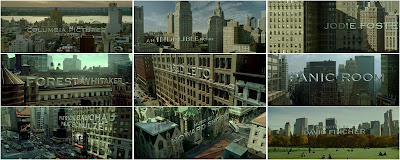
Friday, 19 February 2010
Animatic of Storyboard
Wednesday, 17 February 2010
Art of the Title Sequence:
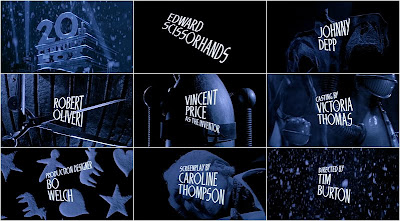
The screen shot above shows the opening title sequence for Tim Burton's, "Edward Scissorhands" movie. From start to finish, the title sequence remains dark and ominous. This is contrasted with a series of images, each title with its own image, that seem playful and almost child like and others more industrial, show metal objects such as scissors. The blue filter used creates a cold and chilling atmosphere. The use of all of those key parts creates suspense and wonder for the audience.
From the still screen shot of the title sequence, you assume the images are static. But after watching the actual sequence it becomes apparent that they are no, and parts of the sequence seem to be in a point of view shot and that the stills above are only part of the titles. the images in the sequence are zoomed out or in on during the presentation on every title.
The titles themselves are in a sans serif font in white, upper case lettering which takes up majority of the frame. Each a reflection of the angles of scissors, creating a relationship with the title of the movie itself. And allowing more information about the forth coming film to be interpreted. the titles seen show the movie title "Edward Scissorhands", the main starring actors, casting, production designer, screenplay and director. But in the full title sequence more are shown.
This title sequence appealed to me because of the strange, non connecting images and dark, cold colours used. I feel that they create an eerie atmosphere. The journey the sequence takes you on makes you want to keep watching the entire movie. I really like the use of the angle of the titles to replicated scissors and the juxtaposing images used throughout caused intrigue. In the full running title sequence, the sound used through out creates a mysterious and magical atmosphere, which the falling snow seen accentuates.
Saturday, 13 February 2010
Skills Audit: Filming and Editing Preliminary Match Cut Exercise
Thursday, 11 February 2010
Hello group 14
Wednesday, 10 February 2010
Skills Audit: Livetype and Soundtrack Pro
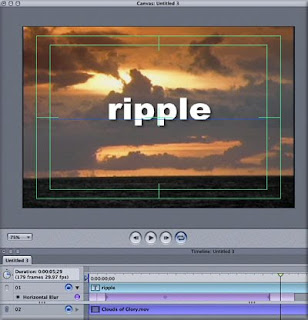 Livetype allows you to type in a simple title and manipulate it. You can change the font, colour, size, background, movement and transition of the title to give it life and make it stand out within your sequence.
Livetype allows you to type in a simple title and manipulate it. You can change the font, colour, size, background, movement and transition of the title to give it life and make it stand out within your sequence.Here is a soundtrack that I made when experimenting with Soundtrack Pro. My inspiration was the TV drama 'Life On Mars' and the cop show genre. I believe this stimulus was helpful in creating a suspenseful soundtrack, as in a cop show you know that something is about to happen but you are never entirely sure what. I thought this stimulus would be a good starting point as it is taking a different approach to the thriller genre in general.
I thought that both programs were very effective in creating a title sequence, as they are both very versatile programs. You can adapt just about anything that already exists within the program to fit your purpose.
Tuesday, 9 February 2010
Skill audit: Livetype and Sound:
Livetype allows us to create a series of titles in various fonts, colours and sizes. With different backgrounds, effects and in different movements, that can be used in Final Cut pro and edited into our thriller opening title sequence.
 Soundtrack allows us to create original pieces of music to feature in the soundtrack of our opening title sequence. Using pre-made clips of different music genres and different instruments. Plus having the ability to change the volume of the clips, we were able to produce our own short compositions that could possibly be used in our final production.
Soundtrack allows us to create original pieces of music to feature in the soundtrack of our opening title sequence. Using pre-made clips of different music genres and different instruments. Plus having the ability to change the volume of the clips, we were able to produce our own short compositions that could possibly be used in our final production. 
Font Types
Serif fonts are a more traditional and are described as formal, compared to fonts of the Sans Serif category. Serif fonts are usually used in broad sheet news papers such as 'The Times'
Examples of Serif fonts are:
Courier.
Examples of Sans serif fonts are:
News and Current Events
Paul and Rachel Chandler, from Tunbridge Wells, were sailing their yacht - the Lynn Rival - towards Tanzania, when they released a distress signal.
http://news.bbc.co.uk/1/hi/england/kent/8371854.stm this is a link for a more closer look at the situation.
I would use this because when filming a kidnapping it is very suspenseful and would be a good idea to take and use as my final peice?
Thursday, 4 February 2010
Font Types
Live type and soundtrack skills audit
Skills Audit Live Type and Sound
In Livetype you can create titles for your thriller and in this programs you can make them in any style you want so you can make it significant like seen in the picture "Smoking Kills"
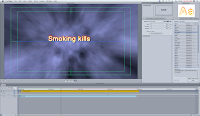 where it is orange to represent it being fire and fire is dangerous and with the background smoke it helps support the logo where smoking is dangerous and can kill. hoverer for your thriller title sequence you could change the font and make it look old or bold and many more but you can make it red to make it significant and to represent danger. So in livetype you can make the titles significant to go with your thriller you are making.
where it is orange to represent it being fire and fire is dangerous and with the background smoke it helps support the logo where smoking is dangerous and can kill. hoverer for your thriller title sequence you could change the font and make it look old or bold and many more but you can make it red to make it significant and to represent danger. So in livetype you can make the titles significant to go with your thriller you are making.Also in this lesson we learnt how to use Soundtrack Pro where it is a programme where you can create the soundtrack for your thriller title sequence. you can make it slow music to build up tension and to make your thriller title sequence suspenseful. Also in soundtrack pro you can get special affects like big explosions or even get sounds like for a city scene which we are thinking about in using so this would be very helpful and it Will make it authentic.
Both the skills are very useful to have to make our thriller title sequence authentic and to make it look like a real production company had made this film and the soundtrack and Livetype will make our title sequence better as it will help us to gain more marks as it will look more like a title sequence.
Teacher comment
Wednesday, 3 February 2010
Thrillers and Sub-Genres
There are many types of thrillers, however, all create suspense in different ways as they are all different types of thrillers so they plot the thrillers differnatly. such as:
Horror thrillers.
Action thrillers.
Political thrillers.
Psychological thrillers.
Religious thrillers.
Spy thrillers.
Medical thrillers.
Legal thrillers.
Crime thrillers.
Conspiracy thrillers.
Drama thrillers.
The Triller i am inspired by are horro thrillers like the red eye becuase Jackson the VILLAN been following Lisa for weeks and knows so much about her that she becomes suitably freaked out. This caught my eye because the theme of a stalker always creates good suspense.
Font Types:
Serif fonts are a more traditional and are described as formal, compared to fonts of the Sans Serif category. Serif fonts are usually used in broad sheet news papers such as 'The Times'
Examples of Serif fonts are:
Times New Roman and Courier.
San Serif Fonts are more informal, modern and 'Friendly', in contrast to the formality of Serif fonts.
Examples of Sans serif fonts are:
Arial and Verdana
Depending on the target audience and genre of the a movie, the fonts used in the opening titles and on advertising materials will vary and are a reflection of both.
The official movie poster for Pearl Harbor uses the font 'Platino.' The use of a serif font has a more formal address toward the audience. The images give us a clue as to what the movie about, war, and the formality of the font suggests the factual nature of the events in the movie. The upper case lettering suggests strength and masculinity.
The font used in the 'Rocky' movie poster, 'Franklin Gothic Heavy', is Sans Serif. Its very strong and bold, which in reflects the personality of the main character of the movie. It also suggests masculinity through the use of upper case lettering, attracting a male dominant audience. Its striking nature instantly captures the audience.
How is suspense created
This film was full of suspense becuase the director made it obvious what the two men where planning to do however, we didn't no when they were going to make the the moveand hijack the plane.
On the plane we see members of the Al-Qaida keep going other to each other and asking question we think they are going to start the move but don't this happens 4 times and each time we get a gutwrenching feeling as the suspense is building.
Then finally nthey start the move and the aggression in the faces as they brutally stab passengers, this was unexpected and created climax and suspense.
Every last tiny detail used by Greengrass is drenched with unbearable tension, especially at the very beginning. Every gesture, every look, every innocent greeting, every puzzled exchange of glances over the air-traffic scopes, every panicky call between the civil air authority and the military - it is all amplified, deafeningly, in pure meaning. And the first scenes in which the United 93 passengers enter the plane for their dull, routine early-morning flight are almost unwatchable.
Monday, 1 February 2010
Font Analysis
News and Current Affairs:
A possible plot for a thriller based on terrorism could be the failing of national security; an attack to cleverly planned and involving the most inconspicuous of people it goes undetected. Once detected a series of suspense building events, such as failed bomb attempts and hostage holding could occur. Multi-narrative perspective could be used to capture the audiences attention, clearly demonstrate actions of various characters and events taking place; successfully creating suspense through the ignorance and contrast of characters in each situation. Much like the technique used in the political thriller 'United 93', where different locations and groups if characters are shown to the audience differently. Exposing certain aspects that others are unaware of.
The reality of situations portrayed to audiences will have a great effect on the audience because of its reality and some what shocking nature of the issue. It instantly has an emotional effect and the possibility of a similar event occurring strikes fear in audiences, even if they do believe they should remain vigilant in society. Aspects raised in political thrillers like this can sometimes educate people in field they were unaware of before, though reality is sometimes exaggerated.
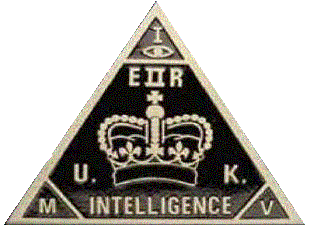
Thriller plots in the media?
News and Current affairs Events
I think this story could be turned into a thriller film as its main theme is murder and would make a good thriller film but also I believe this story would make a good thriller film as Stephen Marshall the Jigsaw man worked for a notorious underground family called the "Adams " and with this element of gangsters and underground i think it is a good chemistry with murder to make a good thriller film.
As this films main theme is murder I think it will make a good a thriller film because with this theme you would be able to create a lot of suspense and by creating a film with a lot of suspense I think it would make a good successful movie. scenes such as where the Jigsaw man would try and kill his prey I think it would have a lot of suspense and with this suspense it would make the audience be on the edge of their seat and would therefore create a good thriller film.


